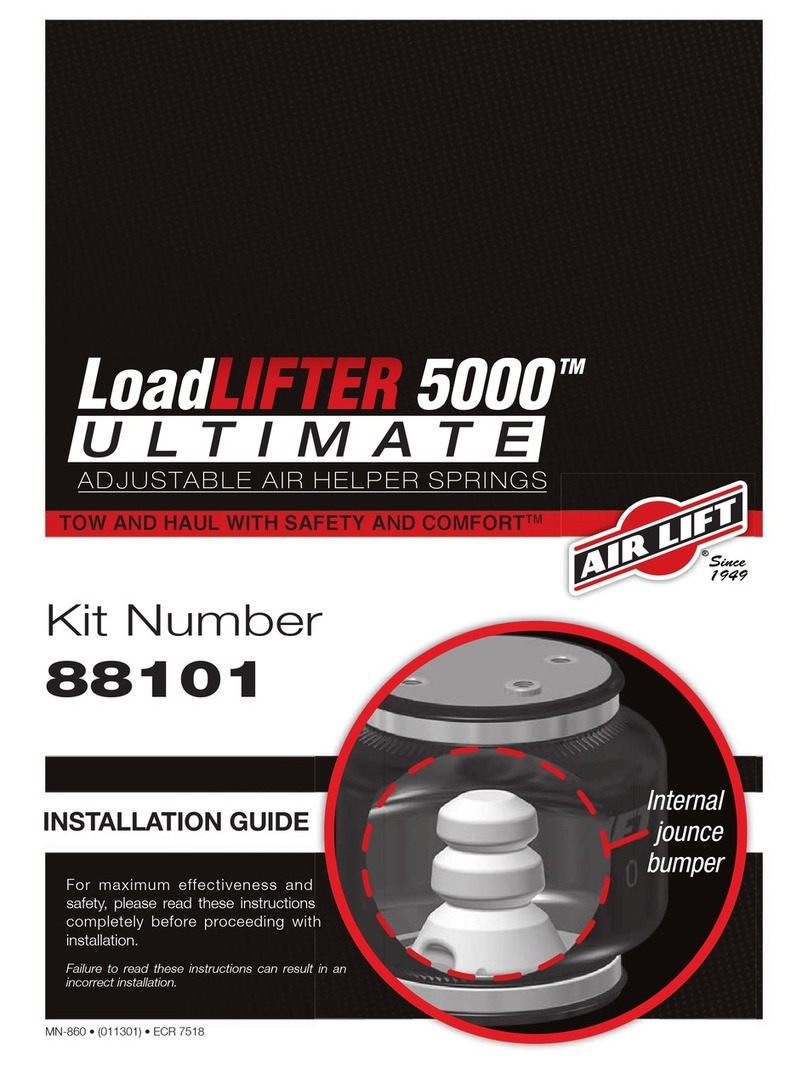
4MN-387
LoadLifter 5000
Installing the LoadLifter 5000 System
5TH WHEEL HITCH
NOTE FOR FORD TRUCKS ONLY: If you have a Reese-style 5th wheel hitch kit installed and
you have purchased kit #57215, you need to order kit #57342 or contact Air Lift customer
service for the correct brackets at (800) 248-0892. Ask for bracket kit #26275.
COMPRESSED AIR CAN CAUSE INJURY AND DAMAGE TO THE VEHICLE AND PARTS
IF IT IS NOT HANDLED PROPERLY. FOR YOUR SAFETY, DO NOT TRY TO INFLATE THE
AIR SPRINGS UNTIL THEY HAVE BEEN PROPERLY SECURED TO THE VEHICLE.
DANGER
GETTING STARTED
1. Support the axle with jack stands, remove the wheels, and raise or lower to obtain normal
ride height (gs. 2 and 3).
8”
g. 3
No Load in Truck
Remove wheels
g. 2
Item Part # Description................................Qty
A1 58437 Bellows (57215) ..................................2
A2 58491 Bellows (57207) ..................................2
B 07475 Upper bracket .....................................2
C 03102 Lower bracket .....................................2
D 11951 Roll plate.............................................4
E 33606 Elbow tting.........................................2
F 10594 2” U-bolt ..............................................4
G 10583 4.5” U-bolt ...........................................4
H 18435 Nyloc nut............................................16
I 18444 3/8” Flat washer .................................16
J 18427 3/8” Lock washer.................................8
K 13377 Upper bracket spacer* ........................8
L 18447 3/8” Large at washer .........................8
M 17159 3/8” x 1.5” Washer head frame bolt ....8
N 17203 3/8” x 7/8” Hex head cap screw ..........8
O 01525 Spacer bar*.........................................4
Dodge Fenderwell Spacer Parts
P 17182 ½” x 2” HHCS* ....................................2
Q 20947 Fenderwell liner spacer* .....................2
R 18419 10/32” Flat washer*.............................6
S 18425 ¼” Nyloc nut* ......................................2
Air Line Assembly
T 20086 Air line assembly* ...............................1
U 10466 Tie strap*.............................................6
V 21230 Valve caps*.........................................2
W 18405 5/16” Flat washer*...............................2
X 21234 Rubber washer* ..................................2
Y 18411 Small star washer*..............................2
X 21233 5/16” Hex nut*.....................................4
*Not shown in g. 1.
HARDWARE LIST
Missing or damaged parts? Call Air Lift customer
service at (800) 248-0892 for a replacement part.
STOP!
































